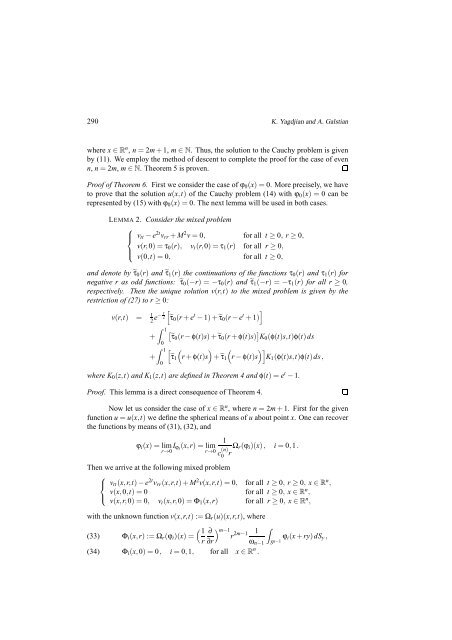The Klein-Gordon equation in anti-de Sitter spacetime - Seminario ...
The Klein-Gordon equation in anti-de Sitter spacetime - Seminario ...
The Klein-Gordon equation in anti-de Sitter spacetime - Seminario ...
Create successful ePaper yourself
Turn your PDF publications into a flip-book with our unique Google optimized e-Paper software.
290 K. Yagdjian and A. Galstianwhere x∈R n , n=2m+1, m∈N. Thus, the solution to the Cauchy problem is givenby (11). We employ the method of <strong>de</strong>scent to complete the proof for the case of evenn, n=2m, m∈N. <strong>The</strong>orem 5 is proven.Proof of <strong>The</strong>orem 6. First we consi<strong>de</strong>r the case of ϕ 0 (x)=0. More precisely, we haveto prove that the solution u(x,t) of the Cauchy problem (14) with ϕ 0 (x) = 0 can berepresented by (15) with ϕ 0 (x)=0. <strong>The</strong> next lemma will be used <strong>in</strong> both cases.LEMMA 2. Consi<strong>de</strong>r the mixed problem⎧⎪⎨ v tt − e 2t v rr + M 2 v=0, for all t ≥ 0, r≥ 0,v(r,0)=τ 0 (r), v t (r,0)=τ 1 (r) for all r≥ 0,⎪⎩v(0,t)=0, for all t ≥ 0,and <strong>de</strong>note by ˜τ 0 (r) and ˜τ 1 (r) the cont<strong>in</strong>uations of the functions τ 0 (r) and τ 1 (r) fornegative r as odd functions: ˜τ 0 (−r) = −τ 0 (r) and ˜τ 1 (−r) = −τ 1 (r) for all r ≥ 0,respectively. <strong>The</strong>n the unique solution v(r,t) to the mixed problem is given by therestriction of (27) to r≥0:[]v(r,t) = 1 2 e− 2t ˜τ 0 (r+e t − 1)+˜τ 0 (r−e t + 1)++∫ 10∫ 10[˜τ0 (r−φ(t)s)+˜τ 0 (r+φ(t)s) ] K 0 (φ(t)s,t)φ(t)ds( ( )][˜τ 1 r+φ(t)s)+˜τ 1 r−φ(t)s K 1 (φ(t)s,t)φ(t)ds,where K 0 (z,t) and K 1 (z,t) are <strong>de</strong>f<strong>in</strong>ed <strong>in</strong> <strong>The</strong>orem 4 and φ(t)=e t − 1.Proof. This lemma is a direct consequence of <strong>The</strong>orem 4.Now let us consi<strong>de</strong>r the case of x ∈R n , where n=2m+1. First for the givenfunction u=u(x,t) we <strong>de</strong>f<strong>in</strong>e the spherical means of u about po<strong>in</strong>t x. One can recoverthe functions by means of (31), (32), and1ϕ i (x)= lim I ϕi (x,r)= limr→0 r→0c (n)0 r Ω r(ϕ i )(x), i=0,1.<strong>The</strong>n we arrive at the follow<strong>in</strong>g mixed problem⎧⎨ v tt (x,r,t)−e 2t v rr (x,r,t)+M 2 v(x,r,t)=0, for all t ≥ 0, r≥ 0, x∈R n ,v(x,0,t)=0 for all t ≥ 0, x∈R n ,⎩v(x,r,0)=0, v t (x,r,0)=Φ 1 (x,r) for all r≥0, x∈R n ,with the unknown function v(x,r,t) := Ω r (u)(x,r,t), where(33)(34)( 1 ∂) m−1r∫2m−1 1Φ i (x,r) := Ω r (ϕ i )(x)=r ∂r ω ϕ i(x+ry)dS y ,n−1 S n−1Φ i (x,0)=0, i=0,1, for all x∈R n .














